
Lysmata debelius is a species of cleaner shrimp indigenous to the Indo-Pacific. It is popular in the aquarium trade, where it is known as the fire shrimp, blood shrimp or scarlet cleaner shrimp.

Cleaner shrimp is a common name for a number of swimming decapod crustaceans that clean other organisms of parasites. They belong to any of three families, Hippolytidae, Palaemonidae, and Stenopodidae . The last of these families is more closely related to lobsters and crabs than it is to the remaining families. The term "cleaner shrimp" is sometimes used more specifically for the family Hippolytidae and the genus Lysmata.

Palaemonidae is a family of shrimp in the order Decapoda. Many species are carnivores that eat small invertebrates, and can be found in any aquatic habitat except the deep sea. One significant genus is Macrobrachium, which contains commercially fished species. Others inhabit coral reefs, where they associate with certain invertebrates, such as sponges, cnidarians, mollusks, and echinoderms, as cleaner shrimps, parasites, or commensals. They generally feed on detritus, though some are carnivores and hunt tiny animals.
Parhippolyte sterreri is a species of marine decapod crustacean in the family Barbouriidae, formerly placed in the genus Somersiella. It is found in marine caves around the Bahamas, Cuba and Mexico and inland anchialine caves in Bermuda.

Typhlatya is a genus of shrimp in the family Atyidae. These are small, stygobitic shrimp found in the West Mediterranean region, Caribbean region, Ascension Island and the Galápagos, although the individual species often have very small ranges. Species in this genus are found in salt, brackish and fresh waters, mostly in anchialine habitats and none in the open sea.

Lysmata is a genus of shrimp in the infraorder Caridea, the caridean shrimp. The genus belongs to the family Lysmatidae. Lysmata are popular ornamental shrimp in the marine aquarium trade for their bright color patterns, interesting behaviors, and ability to control certain aquarium pests such as sea anemones of the genus Aiptasia. They are known to command high prices on the pet market.
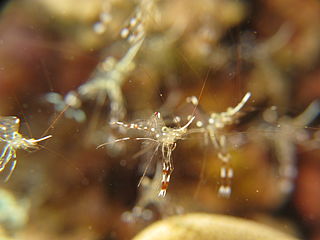
Urocaridella antonbruunii, common names clear cleaner shrimp or red-white cleaner shrimp, is a species of shrimp belonging to the family Palaemonidae. It was described by A. J. Bruce in 1967. It is one of the species that are known as cleaner shrimps.
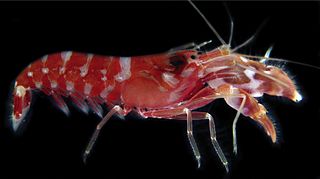
Alpheoidea is a superfamily of shrimp. Species of shrimp in the superfamily Alpheoidea are drag swimmers, as opposed to lift swimmers.
Barbouriidae is a family of shrimp, comprising four genera:

Thor is a genus of shrimp in the family Thoridae, containing the following species:

A shrimp is a crustacean with an elongated body and a primarily swimming mode of locomotion – typically belonging to the Caridea or Dendrobranchiata of the decapod order, although some crustaceans outside of this order are also referred to as "shrimp".

Prawn is a common name for small aquatic crustaceans with an exoskeleton and ten legs, some of which are edible.
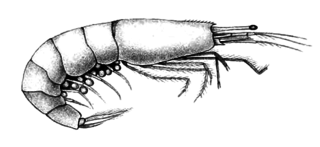
Ogrydes'' is a genus of decapod crustaceans consisting of 13 species. It is the only genus n the monotypic family Ogyrididae.

Periclimenaeus is a genus of decapod crustaceans of the family Palaemonidae which is part of the infraorder Caridea. The genus was named by the English carcinologist Lancelot Alexander Borradaile in 1915. He set out the distinguishing features of the genus as:
Body rather stout, cephalothorax deep, a good deal compressed, abdomen greatly curved Thorax without dorsal swelling. Rostrum rather short, compressed, toothed above only. Outer antennular flagellum not deeply cleft. Antennal scale of good breadth. Mandible without palp. Second maxilliped without podopalp. Third maxilliped narrow, with vestigial arthrobranch.
Parhippolyte uveae, the sugar cane shrimp, is a species of cave shrimp from the family Barbouriidae from the Indian and western Pacific Oceans. It was described by the English carcinologist Lancelot Alexander Borradaile from specimens collected by Arthur Willey in the south Pacific in 1895–1897 and is the type species of the genus Parhippolyte.
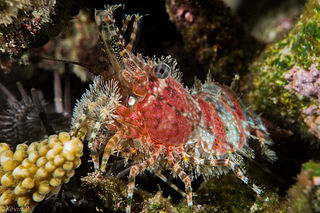
Saron is a small genus of caridean prawns in the cleaner shrimp family Hippolytidae, These are common on the reefs of the Indo-Pacific region and it is possible that there may be many more species yet to be described due to the high variability in colour observed. Some species are kept in the marine aquarium trade.

Saron marmoratus, commonly known as the marbled shrimp, is a species of cleaner shrimp in the family Hippolytidae. It is found in the Indo-Pacific region but in 2013 it was also found off the coast of Lebanon, probably having reached the Mediterranean by Lessepsian migration through the Suez Canal from the Red Sea. It is a popular species in aquaria due to its easy care.

Periclimenes, commonly known as glass shrimp or cleaner shrimp, is a commensal and often symbiotic genus of semi-transparent shrimp within the family Palaemonidae. Species of this large genus feature a wide variety of coloration and patterns, widespread distribution throughout much of the world's tropical oceans, and are often sought out for aquarium trade.

Zenopontonia is a genus of shrimp within the family Palaemonidae.
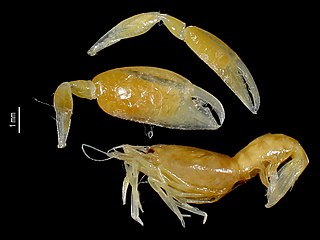
Dactylonia is a genus of shrimp in the family Palaemonidae, first described by Charles Fransen in 2002.

















